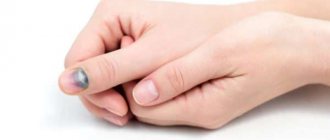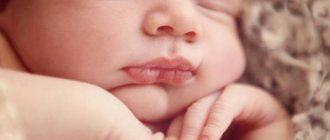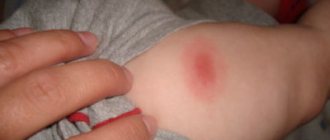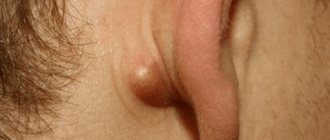Crusts behind the ears in infants are a fairly common phenomenon. Young mothers usually notice them when they carry out daily hygiene procedures. What worries young parents most is that this peeling has an unpleasant odor. In this article we will understand the reason for their appearance and find out how dangerous this phenomenon is for the health of the child.
Crusts behind the ears of a baby are not only an aesthetic problem. They often cause itching, which is why the baby can be capricious, cry, and have trouble sleeping. The child may constantly rub his head and refuse to eat. This phenomenon does not seem serious, but it is necessary to find out the cause. Contact your therapist and he will determine the cause and prescribe the appropriate course of treatment. Next, let's talk about what could provoke the appearance of crusts behind the ears of a baby.
Hygiene procedures
To get rid of this unpleasant phenomenon, the following manipulations should be carried out. How to bathe a baby to get rid of crusts?
- During hygiene procedures, immerse the child in water so that only the face remains on the surface. This way, the crusts will become softer and easier to separate from the skin.
- After bathing, dry the surface behind the ears. Take a small piece of gauze and wrap it around your finger. Soak it in sea buckthorn oil. Lubricate a clean and dry surface to relieve irritation. Be careful: sea buckthorn oil can stain clothes!
- After a couple of minutes, gently wipe the treated areas. Remove any remaining oil and any plaque along with it.
Now you know how to bathe a baby. By following these rules, you can combat the appearance of severe irritation. This kind of ear care is a prevention of the problem. If you do not have the opportunity to bathe your child every day, then try to wipe the area behind the ears every day with a cotton pad dipped in warm water. After this, you can apply moisturizer or baby oil. This will soften the tissue and help gently remove plaque.
Important! Particular attention should be paid to caring for your ears in hot weather. In summer, sweat accumulates especially quickly in this area, and the baby will suffer from diaper rash and irritation. Subsequently, the inflammatory process will begin and pathogenic microflora may join. If you notice that moisture constantly accumulates behind your ears in the heat, then use powder.
Prevention
The main prevention of the appearance of crusts behind the ears in a child is hygiene:
- The child must be bathed regularly and the entire body must be kept clean.
- After bathing, dry this delicate area with a cotton pad or gauze.
- Once a day, wipe the area behind the ears with warm water.
- Soften it with cream once a week.
The appearance of crusts in the area behind the ears requires increased attention in caring for the child. It is necessary to understand that the longer the crusts are on the child’s head, the greater the risk of diaper rash and infection, since the baby is constantly itching from itching. If fever or other manifestations are added to the symptom, you must immediately inform your doctor about it before taking independent action.
The appearance of crusts as a result of the action of staphylococcus
If you follow all the rules of hygiene, and the condition only worsens, then you need to consult a doctor as soon as possible.
Perhaps the cause of the trouble lies in infection with Staphylococcus aureus. What is this? This is a bacterium that belongs to the opportunistic microflora. Most people are carriers of it. But with normal functioning of the immune system and compliance with hygiene rules, the bacterium is not dangerous.
If hygiene rules are not followed and immunity is weakened, bacteria begin to quickly multiply and spread to other parts of the body. They can cause a lot of trouble later. For example, purulent sore throat or meningitis.
In order to confirm that Staphylococcus aureus is the cause of the appearance of crusts behind the ears of a baby, you need to take a microflora culture.
If severe irritation is accompanied by a symptom such as a high temperature, then you need to urgently call a doctor! In this case, the doctor will prescribe antibiotic therapy to stop the infection.
Do not self-medicate with folk remedies. They won't help here, and you'll waste valuable time. Any lotions with herbal infusions can only aggravate the situation, since organic products create a breeding ground for bacteria.
The main reasons for the appearance
The reasons for the appearance of crusts behind the ears of a newborn are different. Often such problems arise due to neglect of personal hygiene rules.
The baby sweats and dirt accumulates behind his ears. In addition, he spits up, and the discharge gets everywhere.
The result is the proliferation of bacteria. In this case, yellow crusts form and an unpleasant odor emanates from them.
Often, such symptoms are provoked by staphylococcus.
If following the rules of hygiene does not give results, you should contact your pediatrician.
It is possible to identify staphylococcus by taking a microflora culture . At the same time, Staphylococcus epidermidis does not cause concern; apart from the scales, there are no changes.
A rise in temperature, the formation of foci with liquid exudate, and the onset of a purulent process are possible.
Such symptoms are a reason to immediately consult a doctor.
The reason that a crust has formed in the baby may be seborrheic dermatitis.
As a rule, pathological changes are noted behind the ears, on the neck, and scalp.
They arise due to the intensive work of the sebaceous glands and excessive secretion synthesis. The top layer peels off and scales appear.
Hormonal fluctuations and allergic reactions provoke such problems.
A mild form of seborrheic dermatitis is not accompanied by additional symptoms.
The following clinical manifestations are typical for severe disease:
- extensive affected area;
- itching;
- redness of the affected tissues;
- deterioration of condition;
- restless sleep.
An allergic reaction can provoke such symptoms. If the baby feeds exclusively on breast milk, the mother needs to reconsider the diet and remove foods that can cause allergies.
Here are the main ones:
Expert opinionAnastasia Mikhailovna MoiseevaPracticing general practitioner, 18 years of experience.
- strawberries, cherries, bananas, citrus fruits, currants, melon, grapes, persimmons;
- nuts, chocolate, honey;
- tomatoes, red bell pepper, beets, eggplants, carrots;
- cocoa, dairy products, coffee drinks;
- smoked meats, seafood;
- mushrooms;
- eggs.
When artificial feeding, the formula should be replaced and complementary foods should be removed.
The following factors can also cause allergies:
- washing powder;
- dust;
- personal hygiene products (oil, shampoo, powder);
- pet fur;
- dust;
- Poplar fluff;
- pollen.
Noticing that the skin is covered with a crust, one can suspect atopic dermatitis, popularly known as scrofula. Weeping areas with scales appear on the skin.
There are several reasons:
- allergy;
- malnutrition;
- lack of sunlight, fresh air;
- maternal alcoholism;
- hereditary predisposition.
Potential allergens
Until the nursing mother figures this out, it is better to exclude potential allergens from the diet:
- whole milk;
- condensed milk;
- sweets;
- coffee and strong tea;
- fish;
- egg yolk;
- red meat;
- nuts;
- baking;
- fruits of bright colors.
If the baby is artificial, then perhaps the doctor will recommend changing the formula. If the child is already receiving complementary foods, then you should monitor which foods increase irritation.
In addition to food, an allergic reaction can be triggered by:
- household chemicals;
- cat or dog hair;
- plant pollen;
- high air humidity and dust in the room.
Preventive actions
To prevent the appearance of scales behind your baby’s ears, just follow these recommendations:
- Observe personal hygiene rules.
- After water procedures, wipe the area behind the ears with gauze and a cotton pad.
- Flush the area with water daily.
- Treat the skin with a softening cream once a week.
- Keep the room where the child is located clean.
- Avoid early introduction of complementary foods.
- Make sure that the baby does not overheat.
- Carefully introduce new products.
- Avoid overeating.
- Wash your baby's clothes and bedding with hypoallergenic powder.
- More time to be outdoors.
- A nursing mother should avoid consuming potential allergens.
- Monitor air humidity and use a humidifier if necessary.
- Wear your baby clothes made of cotton fabrics.
Expert opinionAnastasia Mikhailovna MoiseevaPracticing general practitioner, 18 years of experience. The appearance of crusts behind the ears of a baby is not uncommon.
Young parents often face this problem. It is important to immediately seek help from a pediatrician . An experienced doctor will make an accurate diagnosis and select treatment.e
Previous
CareHow to remove an eyelash from a newborn baby's eye: safe methods for removing hair
Next
Care Newborn baby and bath: when can you start procedures
Expert opinionu-grudnichka-beliy-nalet-na-yazike
Causes of the disease
Scrofula can be caused by food or household allergens. It can also occur against the background of decreased immunity, which occurs due to malnutrition or lack of vitamins and microelements. Another reason is a lack of sunlight and, accordingly, vitamin D. It is also noted that the problem often occurs in children who were born to an elderly couple. The cause of scrofula can also be non-compliance with sanitary standards in the home, or an insufficient level of hygiene.
Scrofula can also be provoked by more serious diseases that the mother suffered, for example syphilis, cancer, tuberculosis. This type of atopic dermatitis often affects children who were conceived by parents who were intoxicated or who regularly drink alcohol.
At first, the disease looks like diaper rash. The skin begins to peel off greatly. Then a golden or yellowish crust forms on the surface. Hence the name. If treatment is not started in time, such formations will soon appear throughout the body. This brings a lot of unpleasant and painful sensations to the child.
Treatment of scrofula behind the ears in children
Consult your doctor for a diagnosis. He will prescribe treatment. It is usually aimed at local lesions. Therapy consists of using zinc ointment and cauterizing the wounds with fucorcin. Bepanten ointment helps a lot. The child should be bathed with a decoction of currant leaves added to the bath. They have disinfecting properties. You can add sea salt to the water. Before taking such medications, you should definitely consult your doctor. In more advanced stages, antibiotic therapy will be required.
Also, the pediatrician will most likely prescribe procedures and medications that are aimed at strengthening the immune system. Doctors recommend that children over the age of one year take fish oil. If a mother is breastfeeding, she can take this supplement herself. The baby will receive it along with milk.
Staphylococcus
There are different types of staphylococcus. One may, apart from crusts, not manifest itself in any way, the other may cause an increase in temperature.
If, after following the rules of hygiene, the baby does not get better, you need to contact your pediatrician. Staphylococcus is detected after the results of culture for microflora. It could be Staphylococcus epidermidis. Its appearance in the body can be considered normal and does not cause other manifestations except dense crusts.
If the crusts are accompanied by an increase in temperature or a serious condition of the child, you should immediately consult a doctor. Usually there is redness around the crusts, they can begin to fester, and in their place, foci with liquid exudate form.
In this case, taking a bath, applying heat to the site of inflammation, and any other independent measures against crusts are contraindicated.
This form of staphylococcal infection is treated with the use of antibacterial and antimicrobial drugs.
To treat the space behind the ears, the doctor may recommend special ointments, disinfectants, and lotions.











